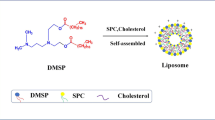Abstract
Purpose. To develop appropriate dosage forms of DNA for gene delivery.
Methods. 3β[N-(N′, N′ dimethylaminoethane) carbamoyl] cholesterol (DC-Chol) was mixed either with Tween 80 alone, or with additional lipid components including castor oil and phosphatidylcholine (PC) or dioleoylphosphatidylethanolamine (DOPE) to make different lipid formulations. The particle size and the physical stability of the formulations upon mixing with plasmid DNA containing the luciferase cDNA were examined using laser light scattering measurement. The transfection activity of the DNA/lipid complexes was tested in presence or absence of serum using a cell culture system.
Results. We demonstrated that many favorable properties as a gene carrier could be achieved by formulating DNA into new dosage forms using Tween 80 as the major emulsifier. Compared to the cationic liposomes, these new formulations transfected different cell lines with an equivalent or higher efficiency. Not only are they resistant to serum, but also form stable DNA complexes which could be stored for longer periods of time without losing transfection activity.
Conclusions. Cationic lipids formulated into different lipid formulations using Tween 80 as a surfactant appeared to have more favorable physical and biological activities than traditional cationic liposomes as a carrier for gene delivery.
Similar content being viewed by others
REFERENCES
W. F. Anderson. Science 256:808–813 (1992).
K. Roemer and T. Friedmann. Eur. J. Biochem. 208:211–225 (1992).
R. C. Mulligan. Science. 260:926–932 (1993).
T. Paul. Annu. Rev. Pharmcol. Toxicol. 33:573–596 (1993).
J. A. Wolff. Gene Therapeutics: Methods and Application of Direct Gene Transfer., Birkhuaser, Boston, 1994.
T. A. Smith, M. G. Mehaffey, D. B. Kayda, J. M. Saunders, S. M. Yei, B. C. Trapnell, A. McClelland and M. Kaleko. Nature Genetics 5:397–402 (1993).
X. Gao and L. Huang. Gene Therapy 2:710–722 (1995).
J. G. Smith, R. Walzem and J. B. Germn. Biochim. Biophys. Acta. 1154:327–340 (1993).
J. H. Felgner, R. Kumar, C. N. Sridhar, C. J. Wheeler, Y. J. Tsai, R. Border, P. Ramsey, M. Martin, P. L. Felgner. J. Biol. Chem. 169:2550–2561 (1994).
J. G. Lewis, K. Y. Lin, A. Kothavale, W. M. Flanagan, M. Matteucci, R. B. DePrince, R. A. Mook, Jr., R. W. Hendren and R. W. Wagner. Proc. Natl. Acad. Sci. USA, 93:3176–3181 (1996).
G. J. Nabel, E. G. Nabel, Z. Y. Yang, B. A. Fox, G. E. Plautz, X. Gao, L. Huang, S. Shu, D. Gordon and A. E. Chang. Proc. Natl. Acad. Sci. USA, 90:11307–11311 (1993).
G. J. Nabel, A. E. Chang, E. G. Nabel, G. E. Plautz, W. Ensminger, B. A. Fox, P. Felgner, S. Shu and K. Cho. Human Gene Ther. 5:57–77 (1994).
X. Gao and L. Huang. Biochem. Biophys. Res. Commun. 179:280–285 (1991).
J. Sambrook, E. F. Fritsch and T. Maniatis. Cold Spring Harbor Laboratory Press. New York. Vol. 1: 21–24 1989.
F. Liu and D. Liu. Pharm. Res. 12:1060–1064 (1995).
Author information
Authors and Affiliations
Rights and permissions
About this article
Cite this article
Liu, F., Yang, J., Huang, L. et al. New Cationic Lipid Formulations for Gene Transfer. Pharm Res 13, 1856–1860 (1996). https://doi.org/10.1023/A:1016041326636
Issue Date:
DOI: https://doi.org/10.1023/A:1016041326636




